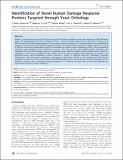| dc.contributor.author | Svensson, J. Peter | |
| dc.contributor.author | Fry, Rebecca C. | |
| dc.contributor.author | Wang, Emma | |
| dc.contributor.author | Somoza, Luis A. | |
| dc.contributor.author | Samson, Leona D. | |
| dc.date.accessioned | 2012-07-23T17:50:25Z | |
| dc.date.available | 2012-07-23T17:50:25Z | |
| dc.date.issued | 2012-05 | |
| dc.date.submitted | 2012-01 | |
| dc.identifier.issn | 1932-6203 | |
| dc.identifier.uri | http://hdl.handle.net/1721.1/71757 | |
| dc.description.abstract | Studies in Saccharomyces cerevisiae show that many proteins influence cellular survival upon exposure to DNA damaging agents. We hypothesized that human orthologs of these S. cerevisiae proteins would also be required for cellular survival after treatment with DNA damaging agents. For this purpose, human homologs of S. cerevisiae proteins were identified and mapped onto the human protein-protein interaction network. The resulting human network was highly modular and a series of selection rules were implemented to identify 45 candidates for human toxicity-modulating proteins. The corresponding transcripts were targeted by RNA interference in human cells. The cell lines with depleted target expression were challenged with three DNA damaging agents: the alkylating agents MMS and 4-NQO, and the oxidizing agent t-BuOOH. A comparison of the survival revealed that the majority (74%) of proteins conferred either sensitivity or resistance. The identified human toxicity-modulating proteins represent a variety of biological functions: autophagy, chromatin modifications, RNA and protein metabolism, and telomere maintenance. Further studies revealed that MMS-induced autophagy increase the survival of cells treated with DNA damaging agents. In summary, we show that damage recovery proteins in humans can be identified through homology to S. cerevisiae and that many of the same pathways are represented among the toxicity modulators. | en_US |
| dc.description.sponsorship | National Institute of Environmental Health Sciences (ES02109) | en_US |
| dc.description.sponsorship | National Cancer Institute (U.S.) (CA55042 ) | en_US |
| dc.description.sponsorship | National Cancer Institute (U.S.) (CA112967) | en_US |
| dc.description.sponsorship | Swedish Research Council. Post-Doctural Fellowship | en_US |
| dc.language.iso | en_US | |
| dc.publisher | Public Library of Science | en_US |
| dc.relation.isversionof | http://dx.doi.org/10.1371/journal.pone.0037368 | en_US |
| dc.rights | Creative Commons Attribution | en_US |
| dc.rights.uri | http://creativecommons.org/licenses/by/2.5/ | en_US |
| dc.source | PLoS | en_US |
| dc.title | Identification of Novel Human Damage Response Proteins Targeted through Yeast Orthology | en_US |
| dc.type | Article | en_US |
| dc.identifier.citation | Svensson, J. Peter et al. “Identification of Novel Human Damage Response Proteins Targeted Through Yeast Orthology.” Ed. Beata G. Vertessy. PLoS ONE 7.5 (2012): e37368. | en_US |
| dc.contributor.department | Massachusetts Institute of Technology. Center for Environmental Health Sciences | en_US |
| dc.contributor.department | Massachusetts Institute of Technology. Department of Biological Engineering | en_US |
| dc.contributor.approver | Samson, Leona D. | |
| dc.contributor.mitauthor | Svensson, J. Peter | |
| dc.contributor.mitauthor | Fry, Rebecca C. | |
| dc.contributor.mitauthor | Wang, Emma | |
| dc.contributor.mitauthor | Somoza, Luis A. | |
| dc.contributor.mitauthor | Samson, Leona D. | |
| dc.relation.journal | PLoS ONE | en_US |
| dc.eprint.version | Final published version | en_US |
| dc.type.uri | http://purl.org/eprint/type/JournalArticle | en_US |
| eprint.status | http://purl.org/eprint/status/PeerReviewed | en_US |
| dspace.orderedauthors | Svensson, J. Peter; Fry, Rebecca C.; Wang, Emma; Somoza, Luis A.; Samson, Leona D. | en |
| dc.identifier.orcid | https://orcid.org/0000-0001-9399-8882 | |
| dc.identifier.orcid | https://orcid.org/0000-0002-7112-1454 | |
| mit.license | PUBLISHER_POLICY | en_US |
| mit.metadata.status | Complete | |
